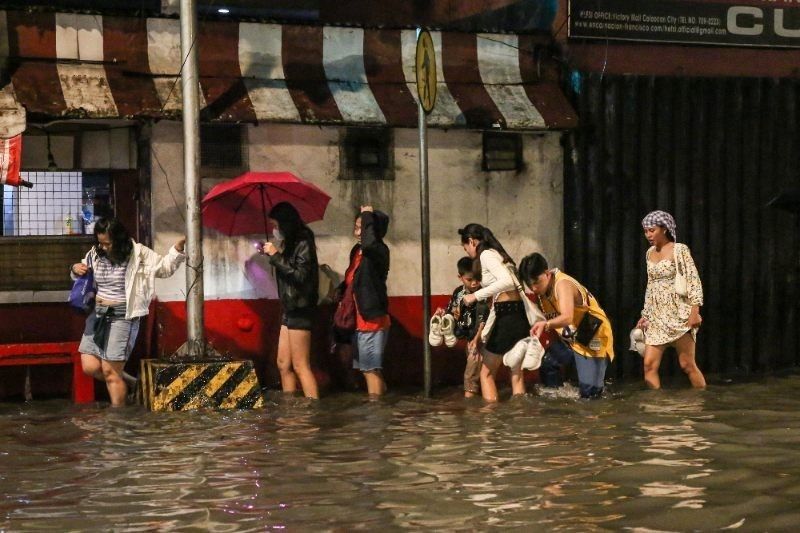DENR, DPWH study water impounding system vs floods

MANILA, Philippines — The Department of Environment and Natural Resources (DENR) and Department of Public Works and Highways (DPWH) are jointly studying the construction of water impounding systems as well as flood control structures as mitigation approaches to climate change and its impacts amid the flooding experienced in many areas in the country following rains brought by Typhoon Egay and the southwest monsoon, Environment Secretary Maria Antonia Yulo-Loyzaga said yesterday.
“We are looking at our respective budgets and our programs to see how we can design multipurpose infrastructure to actually serve the different needs of agriculture, power, water for domestic use and for industry,” Loyzaga said.
She added that the DENR is refocusing the government’s water security strategy to maximize the utilization of the country’s water resources.
Multipurpose water infrastructure include dams, reservoirs, sewage treatment plants, associated irrigation canals and water supply networks which may be used for more than one purpose for economic, social and environmental activities.
Former DPWH secretary Rogelio Singson has proposed the construction of a 200-hectare water impounding area in Pampanga’s Candaba swamp to prevent flooding in nearby and low-lying areas.
Loyzaga said that aside from the DPWH, the DENR is working closely with other concerned government agencies such as the National Economic and Development Authority, Local Water Utilities Administration and Metropolitan Waterworks and Sewerage System in building public water supply facilities for multiple usage.
She added that the DENR is coordinating with the Department of Finance to see how the government can incentivize public-private partnerships for bulk water supply and other projects that can deliver water where it is most needed.
Loyzaga also disclosed that the World Bank has expressed interest in funding multipurpose infrastructure to address sectors critically endangered because of climate change.
Aside from multipurpose water infrastructure, the DENR said the government is also looking at tapping other water sources and to recycle wastewater as the need for stable and steady water supply increases on the back of growing demand and the threat from El Niño.
DOST backs water retention infrastructure
The Department of Science and Technology (DOST) has expressed support for Malacañang’s push for the establishment of a water retention infrastructure in Pampanga as a long-term solution to the worsening flooding problem in Central Luzon, especially in the provinces of Bulacan and Pampanga.
Science Secretary Renato Solidum, guest speaker at the Kapihan sa Manila Bay media breakfast forum yesterday, said there is a need to put in place long-term and smarter solutions to problems arising from climate change and global warming.
Solidum added that solutions should also look at other issues in modern communities in real-world community situations such as over extraction of groundwater and the resulting ground subsidence that exacerbates heavier waterfall in the country’s regions and consequently, aggravates floods during the rainy season.
“Indeed, we should always think that the cause of flooding is there’s excess water from heavy rainfall,” he said.
The DOST chief, however, noted that there is also another emerging challenge of ground subsidence in many urban areas due to over extraction of groundwater.
“There is ground sinking and subsidence that is happening because of the... over extraction of groundwater that is also happening. It really contributes to longer-term flooding,” Solidum said in English and Filipino.
“(The) overall solution should be a combination of many things, especially water retention basins... because if the ground subsides, flooding will become long-term, but the water will come from above,” he explained.
Water retention basins will help in the management of the flow of water during times of heavy rainfall, according to the DOST chief.
“You really need to control the large volume of water to be draining down right away, that is why the President mentioned the importance of the water impounding basin, water retention basin,” he said, referring to President Marcos.
He added that the DOST could help check out the design of proposed water retention basins for its efficacy to manage heavy rain overflow.
“We will have to look at the design, but definitely, whenever you have a water impounding retention basin, more areas will be saved than (not having any),” Solidum said.
He added that building water retention infrastructure should also be complemented by another solution, which is to relocate communities in areas with a chronic flooding problem.
The solution being eyed by the Bulacan provincial government, led by Gov. Daniel Fernando, which is to build a megadike had merit, but the DOST secretary said a dike solution should be thoroughly studied.
“It has to be designed properly,” Solidum said.
He added that dike infrastructure also costs a lot of money.
“It’s good that the local government unit approached San Miguel (Corp.), so they can plan better on how to manage the flood. Of course, you need funding,” Solidum said.
“Eventually, you look at the cost of building things versus just relocating a few people, which would be better for development?” he added.
Dismay
Senators expressed dismay over the massive flooding in many parts of the country after two consecutive typhoons in the last week despite having about a P3-trillion budget for flood control and management programs.
During yesterday’s public hearing of the Senate committee on public works chaired by Sen. Ramon Revilla Jr., senators lamented the bad effects of the massive flooding in many parts of the country, most of which remain submerged.
Sen. Raffy Tulfo urged government officials to look into alleged corruption in the administration of dams amid persistent flooding problems in the country.
Tulfo pointed out the importance of immediately solving the flooding problem, particularly in Metro Manila and nearby provinces such as Bulacan, Pampanga and Cavite. He stressed that the problem is not totally inevitable as floods are completely preventable and avoidable if dams are better run and equipped.
Sen. Cynthia Villar lamented that the pumping stations in her home city of Las Piñas are causing floods instead of addressing the problem, thus she questioned Metro Manila Development Authority (MMDA) Chairman Romando Artes about the agency’s activities.
Artes, however, told senators, “I can say that the pumping stations are working at 100-percent capacity, many have been rehabilitated.”
Revilla also questioned Public Works Secretary Manuel Bonoan as to what happened to the flood control and management programs, which cost about P726 billion for the agency and P9 billion for the MMDA.
Bonoan explained that many of them are still ongoing.
Senators also warned of the possible flooding effect of reclaiming land from Manila Bay during the same hearing.
Senate Majority Leader Joel Villanueva earlier blamed the flooding in Bulacan to reclamation projects as well as the DPWH’s failure to fully utilize its P182-billion flood-control budget this year. - Danessa Rivera, Rainier Allan Ronda, Cecille Suerte Felipe, Marc Jayson Cayabyab, Ramon Efren Lazaro
- Latest
- Trending

































